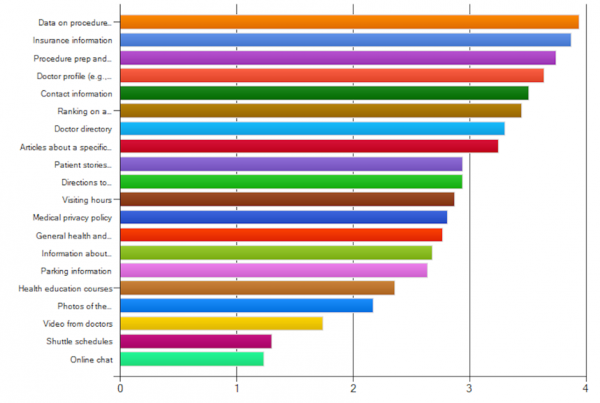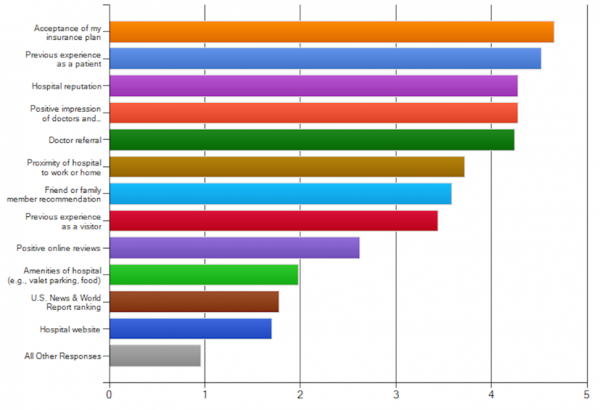Hospital Website Design: Meeting Prospective Patients' Content Needs
When it comes to acquiring new patients, market research shows digital channels strongly topping referral and print strategy. One survey reports 76% of prospective patients use digital channels in the research process to select a care provider. If you want to improve conversion, streamlining your hospital website to align to prospective patient needs is a necessary step.
When it comes to acquiring new patients, market research shows digital channels strongly topping referral and print acquistion strategies. One survey reports 76% of prospective patients use digital channels to select a care provider. If you want to improve conversion from your hospital website, streamlining your website to align to prospective patient needs is a necessary step.
What Content do Prospective Patients Want in a Hospital Website?
If prospective patients are using the internet and your hospital website to evaluate care options, the key question is: what content are they using in making their decision? Third-party research is silent on these topics.
So, to dig into this question, we conducted an online survey of adults in major metro areas seeking to select a hospital or health system for a procedure. Here’s what we learned.
Desired Functionality and Content for Hospital Websites
Prospective patients are hoping to find content on hospital websites that reinforces their confidence in the hospital, provides specific information about the procedure, and helps them navigate the hospital.

The hospital website is critical in educating about and preparing patients for a procedure. Specifically they are seeking information on:
-
Doctors that conduct the procedure
-
How to prepare for the procedure
-
Additional research or articles on the procedure
In addition, the hospital website plays a role in reinforcing the reputation of the hospital and also in learning about the practicalities and financial aspects of receiving care at the hospital:
-
Approved insurance carriers
-
Contact information
-
Visiting hours
-
Parking
What Content Not to Emphasize on Your Hospital Website
Interestingly, prospective patients de-prioritize brand building and rich media content: photos of the facility and videos from doctors being ranked among the least sought after content on a hospital website. In addition, generalized health information – at least while researching for care on a specific procedure – is also less desired.
Patient Journey: Key Decision Factors
To understand some more context we asked prospective patients a follow up question: “When selecting a hospital for a procedure, rate the importance of the following factors in your final decision.”

The factors that influence the final decision can be grouped into the following categories:
-
Payment – ultimately, patients want to understand if the cost of the procedure is covered by their insurance company. If the insurer box isn’t checked, then the rest of the factors don’t matter.
-
Reputation – this includes overall branding as well as recommendations and referrals from friends, family, reviews and a doctor.
-
Experience – Has the prospective patient been a patient before or even been in the hospital as a patient? These have an impact on the decision process
How to Use These Insights to Improve Your Hospital Website
This information can be used to structure the content on the website.
-
Insurance: We’ll want a clear pathway to the insurance information. This content ranks first and second in both questions.
-
Location Matters: If your hospital has multiple locations or clinics make sure that this information is readily available. Don’t just list this information in one spot on the site and hope that prospective patients find the information. We recommend adding location information contextually onto services pages. This question also reveals that prospective patients are looking for “convenience” – location is just one example of this. Be sure to highlight other convenience options.
-
Previous Experience: The website can’t make up for a lack of real, in-person experience, but you can think about what a prospective patient is gaining from a previous visit: a sense of comfort and familiarity with the process and location. Based on this, the hospital website should be designed to help people feel comfortable: maps, location, and clear, friendly process.
Why Hospitals Struggle to Align the Website to Prospective Patient Needs
Designing a website around prospective patient needs is challenging for many hospitals because they are large, decentralized institutions with competing audience priorities. So, hospitals default to ordering their websites around the institutional structure of the hospital. In other words, hospital website navigation is organized around the internal “org chart” of the hospital. Getting alignment around the primary audience – ideally the prospective patient – can be a political challenge. And existing technology and ownership of the website make it hard.
How do I make my site focused on users?
As part of our design engagements for hospital and healthcare websites, we focus on understanding the needs of prospective patients. This includes interviews with patients and referring doctors, competitor reviews, user tests of websites and surveys. The most effective means that we have found to overcome political barriers is to conduct user interviews with video capture of prospective patients. These videos reveal the struggles of users and challenges perceptions.